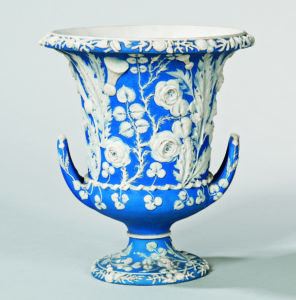
Wedgwood is ripe for collecting with examples manufactured in a variety of bodies, colors and subject matter over 260 years of production. To the novice, Wedgwood is often light blue jasper or perhaps a familiar dinner service from childhood. What they might not realize is the breadth of production or the fact that Wedgwood collectors span the globe. Follow these pointers to learn how to identify Wedgwood and what to look for in this collecting area.
1. Quality: Look for especially high relief with good undercutting and fine details. This factor is a crucial indicator. Use the pointers below to hone your knowledge and your eye.
2. Marks: 18th-century marks include an all lower case mark, a Wedgwood & Bentley mark, and an upper-lower case mark. 19th-century marks were pretty standard variations of all upper-case lettering, the second half of the century including a three letter date code in many cases. Late in the 19th century, ENGLAND and MADE IN ENGLAND were added and again with some variations. Much of the more “modern” Wedgwood Jasper produced from the 1950’s onward have the year impressed as well as the mark.

3. Texture: The surface of Jasperware produced in the 18th century is silky smooth to the touch. As time went by that smoothness became more granular with 20th-century examples feeling quite rough by comparison.
4. Color: Specific colors were produced during certain periods; even with the trademark blue there are so many variations in tone that help in determining age.


5. Literature: There are a tremendous number of books on the subject, most with excellent photos. Visit your local library or bookseller.
6. Museums: While many major US museums display wonderful examples of Wedgwood, the largest and most comprehensive collection of Wedgwood ceramics outside of England is housed at the Birmingham Museum of Art in Alabama.
7. Auctions: Previews allow you to not only see fine examples in person but also handle them and speak to the specialist about them.
8. Wedgwood groups: Regionally in the US there are the Wedgwood Societies of Boston and Washington, D.C. There is also the Wedgwood International Seminar which is in a different US city each year. The lectures and the camaraderie that comes with participating in these groups is top notch.
9. Internet: Wedgwood discussion groups on Facebook and the like where you can see what others post, ask questions and see the variety of wares collected.
10. Collect: Interesting examples can be found for any budget and the breadth of styles produced mean Wedgwood can fit into any decor. All in all, Wedgwood is a most enjoyable and decorative category of collecting.
Consider Reading : Wedgwood Jasperware: Now is the Time to Buy


You didnt want to mention solid color jasper compared to dipped?
I have finest Aynsley Fine Bone China series Queens Plate condition as new that I would like to sell I forward pictures and inventory 148 pieces, I could bring sample into your shop if you would like to see?
All purchased in Chinacraft London all documentation available.
What is your opinion about putting up for Auction?
Thank You,
Respectfully,
Joseph Vasquez
Hello Joseph, For an evaluation of your china please contact the Skinner Appraisal Department – they would be more than happy to help you find more information as well as provide an appraisal/evaluation for you. You can contact the Appraisal Department by phone at 508-970-3299 or email evaluations@skinnerinc.com. If you can provide photos – here is the link to the appraisals form on our website: https://www.skinnerinc.com/selling/auction-evaluation-form/ Thank you!
Do you buy Wedgwood? I inherited many pieces
Hello Deborah, Thanks very much for your message. If possible, please submit images and a detailed description of your Wedgwood to the Appraisal Services Department: https://www.skinnerinc.com/selling/sell-at-auction/ or at evaluations@skinnerinc.com and our Appraisals Department will return any information that we can to you as well as an auction evaluation. Thank you!